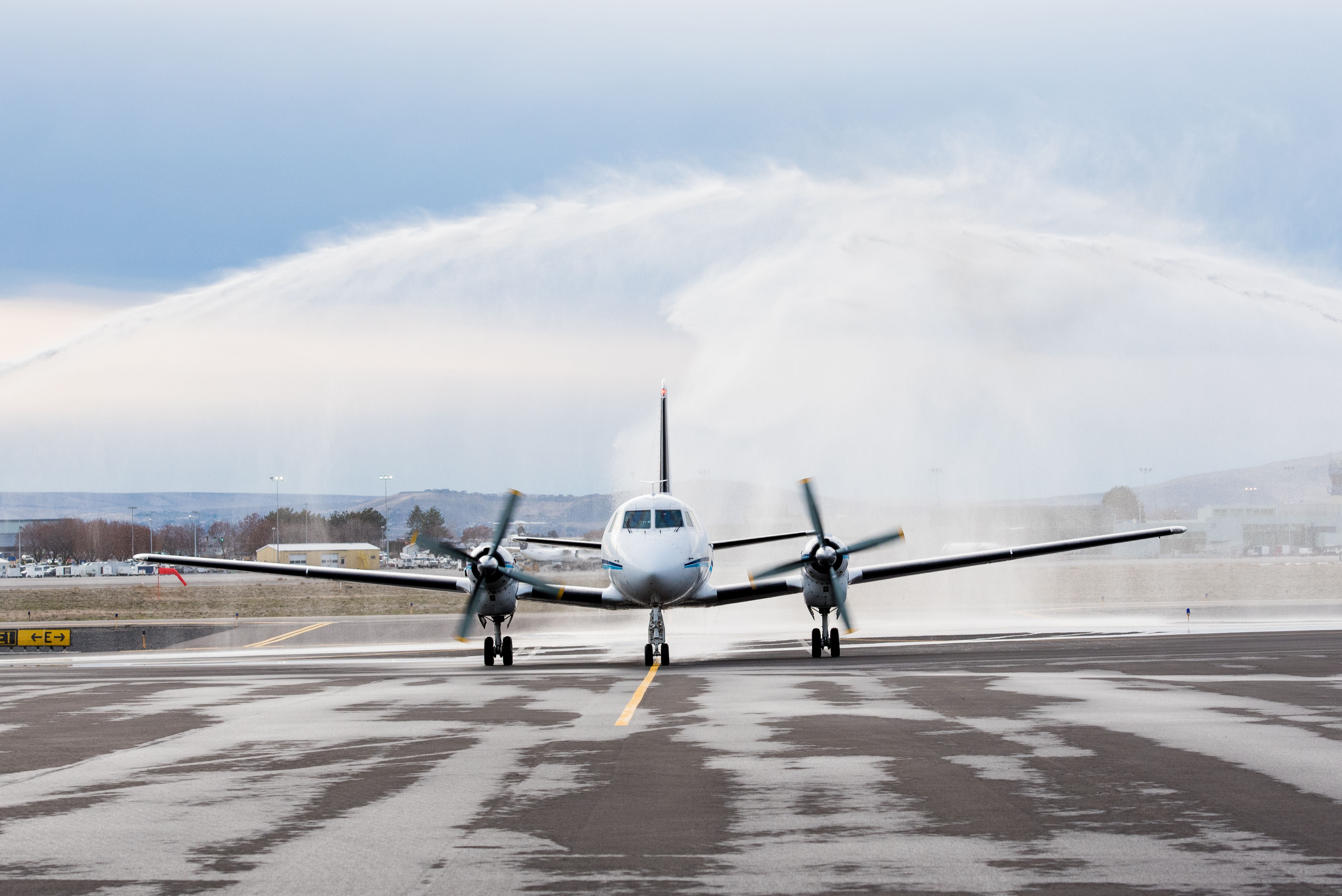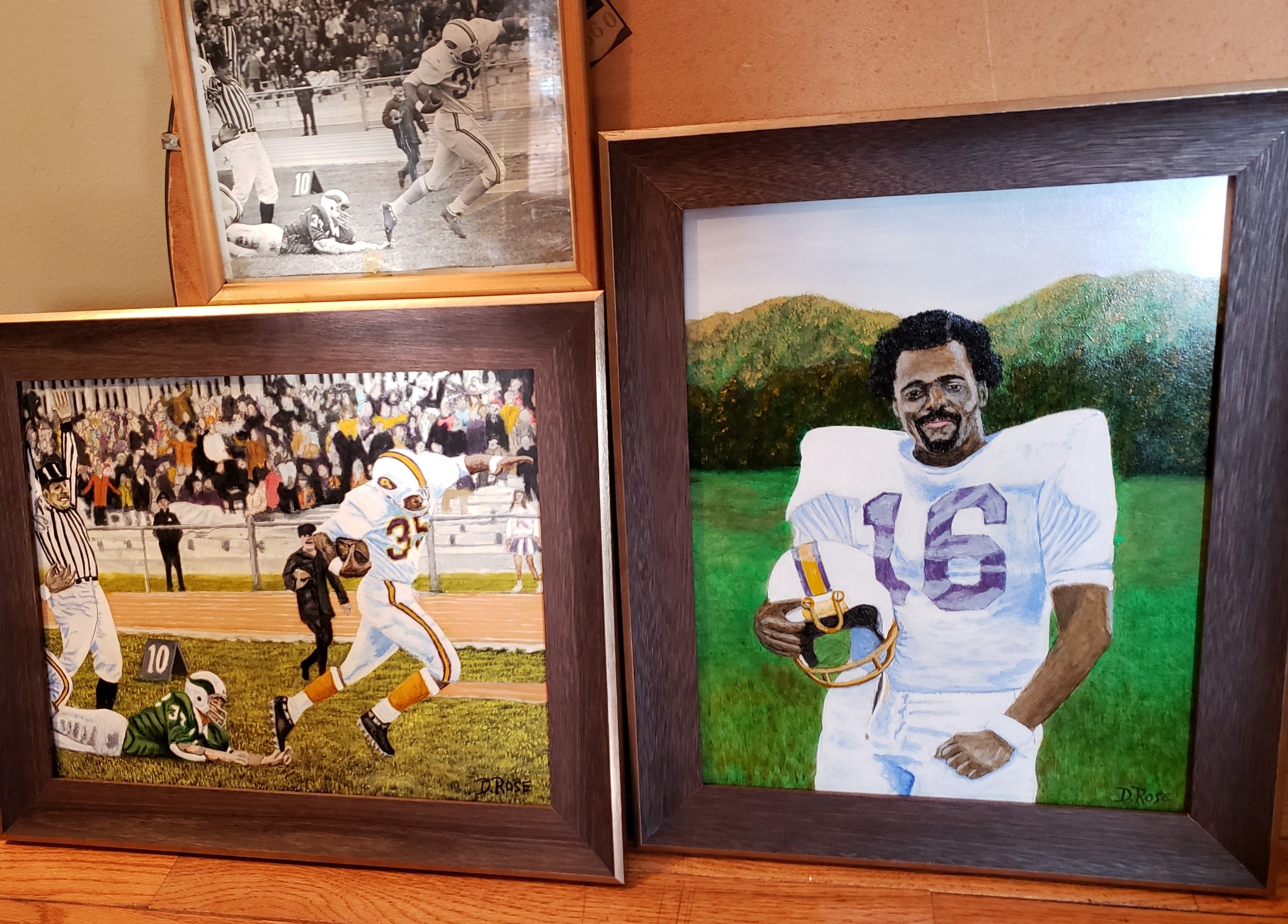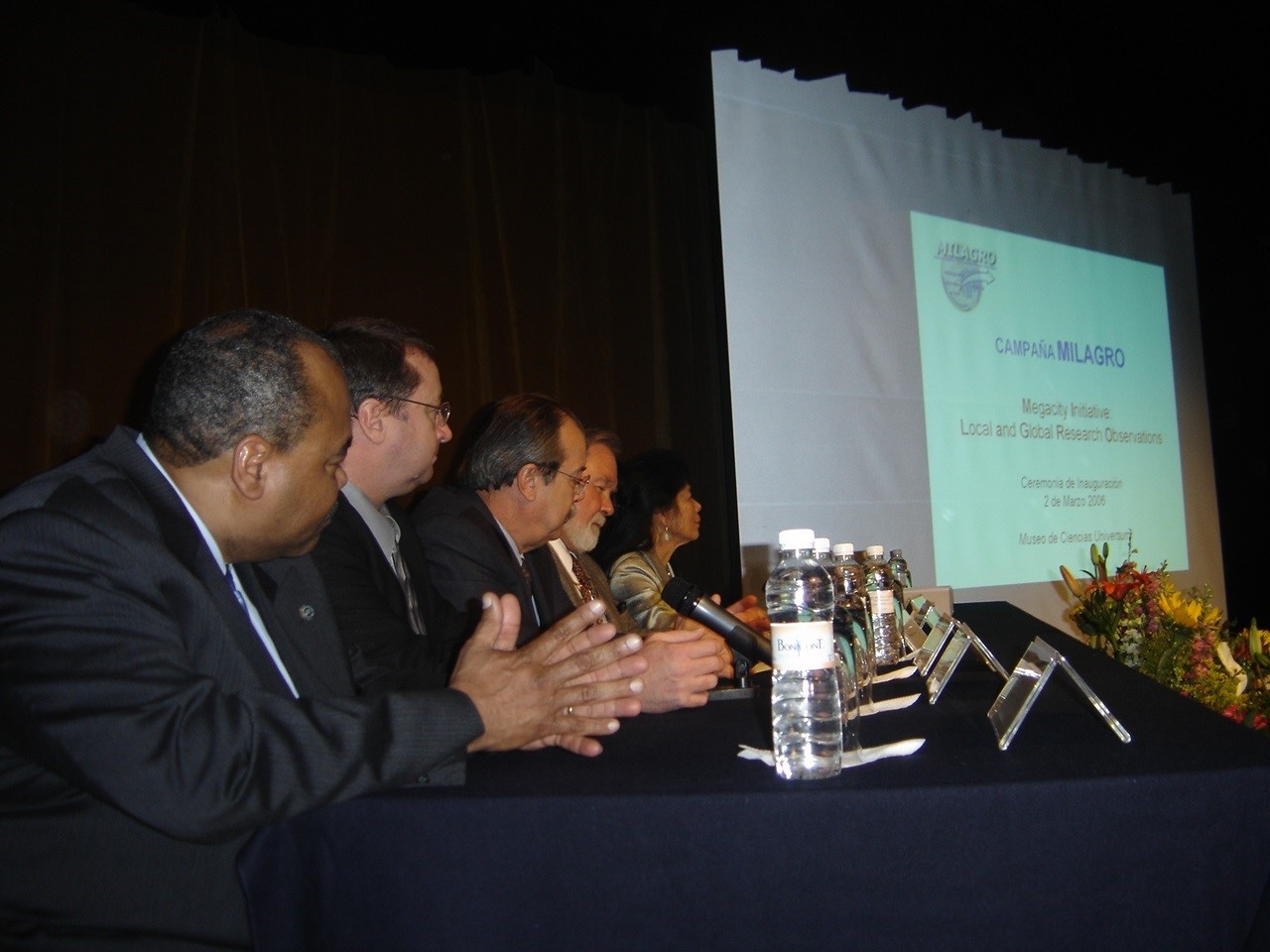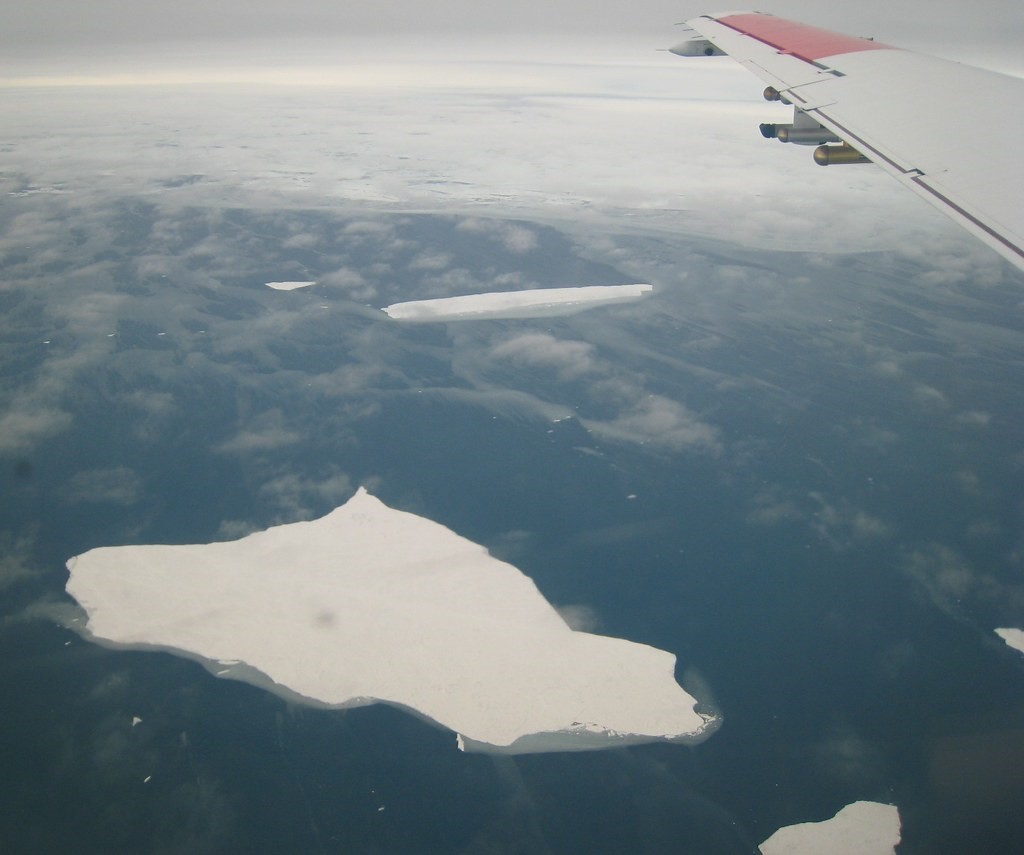Airborne Program Expert Rickey Petty Nears a Goal Line
Published: 22 June 2020
The longtime ARM Aerial Facility program manager and die-hard meteorologist prepares for a studious retirement

One day in the fall of 1971, a 19-year-old football player at the State University of New York at Albany sprinted across the goal line to score a touchdown.
A year later, the nimble teenager traded running the ball for running analyses of meteorological data.
That trade, from sociology to the sciences, was the start of a long career for Rickey Petty, now a 26-year program manager and meteorologist with the U.S. Department of Energy (DOE).
On June 30, 2020, he bows out of his professional work life―ready, says Petty, “to cross the finish line of retirement.”
He made the announcement to his colleagues on June 8, 2020, during a routine call-in meeting.
“I’ve had a lot of fun in atmospheric science, just by being an observer of reality,” says Petty.
In life after DOE, he will travel (when it’s possible again), dig into family history, mentor science-interested youth, and read the many books he has set aside.
In all, says Petty, “I have about 20 items lined up on my retirement to-do list.”
The reading will include historical explorations of how ancient Greek and Roman civilizations benefited from African contributions to science, mathematics, and philosophy.
There will be charity and committee work too. Petty is a member of the Montgomery County, Maryland, branch of the National Association for the Advancement of Colored People. He is also chair of the branch’s Labor and Industry Committee.
“I feel good about my path forward,” says Petty.
Enabling New Frontiers
“I will miss working with Rick. His positive attitude and inside knowledge of how DOE works have made him a great colleague.”
Sally McFarlane, DOE ARM program manager, on longtime ARM Aerial Facility Program Manager Rickey Petty
Within DOE’s Atmospheric Radiation Measurement (ARM) user facility, Petty is program manager for the ARM Aerial Facility (AAF)―and has been since the AAF’s inception in 2006.
ARM deploys surface instruments worldwide at fixed-location and mobile ground observatories, but it also collects data from airborne platforms, including planes, unmanned aircraft, and tethered balloons.
Throughout his DOE career, Petty has witnessed the agency’s airborne systems in their infancy and helped shape their development. He has largely been a convener and facilitator, often as part of multi-agency groups looking for common ground.
Starting in 2010, for instance, Petty oversaw negotiations with the Federal Aviation Administration (FAA) to open observational airspace in Alaska. In 2015, the FAA granted DOE flight access to restricted airspace at Oliktok Point, on the southern coast of the Arctic Ocean.
The action opened a new chapter of ARM-conducted polar atmospheric studies. ARM expanded the research footprint of its North Slope of Alaska atmospheric observatory, prime terrain for understanding fast-changing patterns of temperature, cloud cover, precipitation, and aerosols in polar regions.
“Rick is a really good human being―always supportive,” says AAF Manager Beat Schmid, an expert in airborne atmospheric research at Pacific Northwest National Laboratory in Washington state. “We’ve had some tough times in AAF,” including in 2015, when ARM’s then-research aircraft, the Gulfstream-159 (G-1), was nearly retired.


Petty helped stave off that fate for a few years. The G-1 went on to fly more research missions, though it was finally decommissioned in 2019. Its Bombardier Challenger 850 replacement will be operational in 2023.
As AAF program manager, Petty consults on budgetary matters, flight operations, and safety issues with DOE ARM Program Manager Sally McFarlane.
“I will miss working with Rick,” says McFarlane. “His positive attitude and inside knowledge of how DOE works have made him a great colleague.” (The retirement party will be “virtual,” she says, followed by an in-person gathering when it’s possible a few months from now.)
McFarlane adds that “in particular, Rick has been a great mentor to me on understanding DOE aircraft policies and procedures and the Small Business Innovation Research (SBIR) and Small Business Technology Transfer (STTR) programs.”
Petty is technical topical manager for both programs, which enable new research frontiers.
One SBIR/STTR focus is aerial research technology that provides data to advance the predictive understanding of integrated earth systems. That’s in line with the mission of the Earth and Environmental Systems Sciences Division within DOE’s Biological and Environmental Research (BER) program.
Petty’s work also puts him in the heart of cloud, precipitation, and aerosol investigations in one more way: He has been part of DOE’s ARM-ASR Coordination Team (AACT).
ASR stands for Atmospheric System Research, which funds research on atmospheric processes and modeling. The AACT fosters communication between ARM and ASR.
Old Virginia

Petty was born in 1952 in Danville, Virginia, 10 miles from the North Carolina border. At the end of the Civil War, his native city was the last capitol of the Confederacy. During Petty’s boyhood, Danville was a bustling cotton and tobacco town deep in the heart of the segregated Jim Crow South.
“Society was segregated,” he says. “A lot of things as a youth you take for granted. You accept the lay of the land. But African Americans found a way to navigate and be competitive at various levels,” including sharp public schools run by graduates of historically black colleges and universities.
Petty’s father, Charles, was a chef at the Hotel Danville.
His mother, Roberta, worked in the cotton mills.
“She was a strong, church-going woman,” says Petty. “She put the fear of God into me.”
His mother had only an eighth-grade education, he adds, but she possessed pointed survival instincts and a conviction that “education was critically important. I respected her more than the average PhD.”
Petty grew up with two older half brothers, Henry Myers and Mickey Petty. Henry, an outstanding local baseball player as a youngster, graduated as class president and valedictorian from John M. Langston High School in 1958. He worked in the cotton mills and died in 2007. Mickey, a Langston graduate in the early 1950s who served in the Army during the Korean War, is now a retired chef in his 80s.
Of his two older half brothers, says Petty, “They were―and are―my heroes.”
Spanish Harlem
“Considering the constraints of Jim Crow, a lot of African Americans just had to find a way to survive.”
Petty on moving with his mother from Virginia to New York when he was a child
Petty is named after Ricky Ricardo, a character on “I Love Lucy,” his mother’s favorite television show.
He was 7 when his father died. The next year Petty and his mother moved to New York City, where there was work and help from a few distant cousins.
“Considering the constraints of Jim Crow,” says Petty of his mother’s brave move, “a lot of African Americans just had to find a way to survive.”
However, the culture-shocking relocation experiment lasted only through fifth grade before they moved back to Danville.
Four years later, in the fall of 1967, Petty attended his first semester of high school at Langston, where he was on the school’s football team. That winter, because of better opportunities, mother and son returned to New York. Petty enrolled as a second-semester ninth grader at Haaren High School (now an office building) on 10th Avenue in Manhattan. Next door was a perfume factory, and down the street was an Orthodox Jewish school.
Petty’s Spanish Harlem neighborhood was an immersive multicultural environment, he says―a liberating experience “I carried around with me the rest of my life.”
Albany Epiphany

Interviewing black business owners for a high school class project inspired Petty to study social sciences at SUNY Albany (B.S., atmospheric sciences, 1975).
But halfway through his college years, he asked himself, “What do you know now that you didn’t know in high school?”
The answer was, “Not much.” That propelled Petty into the physical sciences, “a practical career path” that he says required a string of backbreaking semesters to make up course requirements.
Luckily, he had science heroes, including atmospheric sciences professor Harry Hamilton, his academic advisor and a proponent of exposing non-majors to meteorology.
During his career at DOE, Petty also came to know another African American atmospheric scientist, Warren Washington, a pioneer in early climate modeling who retired in 2019 after 54 years with the National Center for Atmospheric Research. (Washington was on the Biological and Environmental Research Advisory Committee, or BERAC, for most of Petty’s career at DOE.)
In college, Petty was also influenced by SUNY Albany’s Lance Bosart, an MIT-trained meteorologist who specialized in large-scale weather systems.
SUNY Albany atmospheric scientist Volker Mohnen, who taught a graduate-level air pollution course, enlisted Petty to collect air samples on the rooftop of a four-story building in downtown Albany. The aim was to get air data on lead and bromine isotopes linked to leaded gasoline. (Petty delivered his samples to the university’s Ion Beam Laboratory for analysis.)
The project was very successful, says Petty, and “I began to sense that my favorite thing was going out into the field to collect data.”
Data Fever
After graduating from college in December 1974, says Petty, “my financial resources were highly constrained.” So he bypassed graduate school (to his regret, he now says) to get into the workforce.
Petty was a budding scientist back then, newly enamored of chemical reactions and equations. But it was not until three years later, after a stint in Manhattan with the General Motors Assurance Corp., that he got back to atmospheric physics.
In the mid-1970s, acid rain studies were the order of the day. For one, scientists were eager to measure the chemistry and atmospheric transport patterns of degrading air quality in the northeastern United States, mostly linked to coal-fired power plants.
In 1977, Petty joined Brookhaven National Laboratory in New York, where he helped collect data on coastal meteorology. Researchers studied sea-breeze onshore flow onto southern Long Island and measured power-plant emissions for the DOE-led Multi-State Atmospheric Power Production Pollution Study (MAP3S).
“I did a lot of data collecting in my day. I loved it.”
Petty
Researchers at BNL were interested in downwind dispersion characteristics, he says, including the ratio of sulfur dioxide to sulfate as a function of downwind distance. Both are chemicals linked to coal-fired power generation.
MAP3S teams at BNL used instrumented aircraft, balloons, marine buoys, and even an instrumented World War II landing craft module to collect over-water measurements. But one of the lab’s first MAP3S tasks was to get air data at a pig farm in Shelbyville, Indiana, which was the base station for pibal (pilot balloon) releases during the field program. Going there on his second day on the job was Petty’s novel introduction to DOE research.
At BNL, Petty worked with Robert Brown, his immediate supervisor; Martin Leach, a researcher then working on his PhD; and Aristides Patrinos, who befriended Petty and went on to be deputy director at BER as well as a force behind DOE’s role in the Human Genome Project.
The BNL experience turned Petty’s scientific eye to airborne instruments, a career path that he followed to DOE.
On air traffic screens at the local airport, he tracked transponders on tetrahedral balloons (“tetroons”). Petty also launched tethersondes into the sky, used an optical instrument called a theodolite to determine vertical wind profiles, drove a truck-trailer rig fitted with an early acoustic sounder, and took to the skies in a two-engine Britten-Norman Islander aircraft to help with atmospheric chemistry studies.
“I did a lot of data collecting in my day,” he says, as well as software analyses of the measurements. “I loved it.”
Wind Roses

In 1981, Petty took a job as a staff meteorologist with NUS (Nuclear Utilities Systems) Corp., a Maryland-based environmental environment and energy consulting firm.
He was a project meteorologist, which involved writing annual reports for the Nuclear Regulatory Commission on his assigned power plants; tracking and remotely integrating meteorological data from plant met towers; and creating scenarios for planned and accidental radiological dispersions.
During his eight years with NUS, Petty programmed wind-frequency distribution charts needed for radiological dose assessments by drafting wind roses―graphical displays of wind speed and direction.
Along the way, he also worked on a few DOE contracts relating to environmental impact statements and spent nuclear fuel storage at national laboratories.
At NUS, Petty encountered numerous publications addressing climate impacts. The observation of long-term meteorological data also gave him insights into the trending of maximum and minimum data extremes.
“I began to see trends in the long-term meteorological data that broke with normal historical averages,” he says.
In 1993, Petty was a peer reviewer on a panel looking at funding opportunities for a DOE program called Atmospheric Studies in Complex Terrain (ASCOT).
Established in 1978, ASCOT was intended to answer some emerging questions: What kind of technology was needed to measure air transport and dispersion processes? And how do you assess the impact of air quality in various kinds of terrain?
Nocturnal wind flow structures and related phenomenon were already familiar to Petty, along with regulatory issues regarding air quality. When a DOE position was posted in 1994 looking for that kind of science and regulatory experience, “my qualifications guided me to the job,” he says.
ASCOT and Beyond

On May 15, 1994, Petty joined DOE’s Office of Energy Research, now the Office of Science, as program manager for ASCOT.
He had roles in both ARM and what was then the Atmospheric Chemistry Program (ACP), a precursor to ASR. In the early 1990s, ACP focused on uncertainties related to ground-level ozone, a pollutant that increased health risks and degraded visibility. (Petty was later the ACP program manager.)
In 1994, ARM was just a few years old and making its initial forays into airborne research. Petty worked with ARM’s first program manager, Peter Lunn, and later Wanda Ferrell, who led the ARM science team from 2000 to 2006 and was later ARM program manager.
Back then, DOE had leased a G-1 research aircraft from Battelle Memorial Institute. (Not long before, the aircraft had collected data in Kuwait on the impact of oil fires during the Gulf War.)
Petty also did business within DOE’s Office of Aviation Management, the beginning of a career-long thread in the agency’s airborne research platforms.
In 2000, he was behind the scenes during the ARM/FIRE Water Vapor Experiment (AFWEX), which used a Model 281 Proteus aircraft flying above ARM’s Southern Great Plains atmospheric observatory. It could fly piloted or not, and it carried ground-controlled instruments.
By 2001, Petty was part of a review of ARM’s Unmanned Aerospace Vehicle (UAV) program, an AAF precursor for which Petty became program manager in 2006. (From there, he transitioned to being AAF program manager.)
The UAV program pioneered using UAVs for science observations in civilian airspace and was ARM’s first attempt to pair ground and air observations. It lasted from 1993 to 2006, when the AAF was established and Petty became program manager.
Mexico City (and More)

In 2006, Petty oversaw DOE operations during a multi-agency field campaign in Mexico City called MILAGRO—Megacity Initiative: Local and Global Research Observations. (A megacity has 20 million or more inhabitants.)
The campaign―a search for data on particulate sources, concentrations, transport, and transformations―relied heavily on instrumented aircraft. MILAGRO brought Petty back to his college, BNL, and industry roots as a collector of data on airborne pollutants.
“Mexico City was a hotbed of megacity pollution, a laboratory surrounded by mountains,” says Petty, who worked on funding, logistics, workshops, and a flurry of interagency negotiations. “We were up against trying to pull together an international scientific collaboration.”
DOE’s component of the field campaign, called Max-Mex (Megacity Aerosol Experiment in Mexico City), focused on the evolution of aerosols; gas-aerosol interactions; and the physical, chemical, and optical characteristics of aerosols in the city’s plume of polluted air. The G-1 aircraft was in operation, as well as an instrumented DOE ground site.
That part of MILAGRO, says Petty, “provided insights into the understanding of secondary organic aerosols (SOAs).”
SOAs are made in the atmosphere when surface organic particles are transformed by contact with traces of oxidized hydrocarbon gases in polluted air.
MILAGRO was a programmatic crucible for Petty, who had just taken on Patrick Crowley’s aviation management role. The experience, he says, made him “a jack of all trades.”
His breadth of administrative reach led Petty to other roles and logistical adventures. The year 2007, for example, was a big one:
- Petty helped assemble 120 international experts in atmospheric science and wind energy―from federal agencies, industry, and universities―to develop a comprehensive report on wind energy and its climate effects.
- From 2007 to 2011, he was the program director of BER’s Global Change Education Program (1998–2013). Among other missions, the program awarded fellowships to PhD students in fields related to atmospheric, terrestrial, and climate modeling science.
- Petty started logistical work on the 2008 international, multi-agency Indirect and Semi-Direct Aerosol Campaign (ISDAC) to observe polar cloud and aerosol systems. ISDAC collected ground data at ARM’s North Slope of Alaska observatory and used a Canadian Convair-580 aircraft to collect airborne measurements.
“My 26 years have gone by in a zip. I couldn’t have asked for a more rewarding career. I’m proud to have been part of the science that has been done.”
Petty, who will retire from DOE on June 30, 2020
“My 26 years have gone by in a zip,” says Petty. “I couldn’t have asked for a more rewarding career. I’m proud to have been part of the science that has been done.”
‘The Workings of Nature’
By the 1980s, Petty had married his wife, Laura, a Boston native who worked for the Department of the Navy in Crystal City, Virginia. She died in 2015. His mother died the year before.
As luck would have it, however, Petty has family to turn to after he leaves DOE.
He and his wife raised a stepson, Amal Lee, who retired from the Navy in 2015 and lives in San Diego. (As in the Navy, Lee works in security.) Lee’s wife is still in the Navy.
Petty and his wife also raised an adopted son, Isaiah Payne, who is an entrepreneur in San Diego. There are also two granddaughters: Amalari Lee, age 10, and Sierra Lee, a registered nurse doing graduate work at Georgetown University.
Then there is a kind of extended family for Petty―the youth he has mentored over the years through charities in suburban Maryland.
“A lot of kids nowadays are intimidated by the sciences,” he says. “I try to encourage them to observe the workings of nature.”
In all, “I feel blessed,” says Petty. “This is who I am.”
Keep up with the Atmospheric Observer
Updates on ARM news, events, and opportunities delivered to your inbox
ARM User Profile
ARM welcomes users from all institutions and nations. A free ARM user account is needed to access ARM data.


















